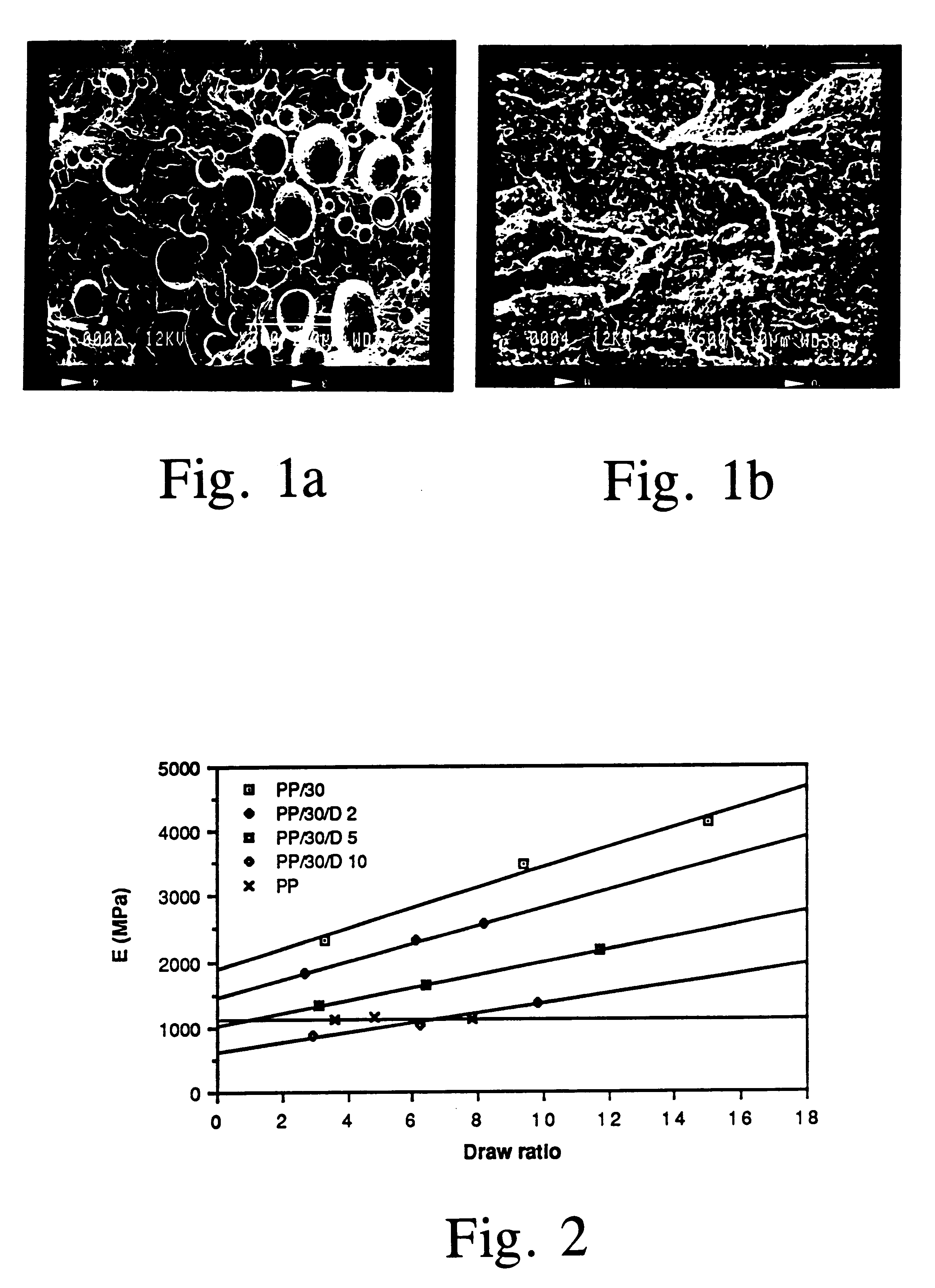Liquid crystal polymer blends, process for the preparation thereof and products manufactured from the blends
- Summary
- Abstract
- Description
- Claims
- Application Information
AI Technical Summary
Benefits of technology
Problems solved by technology
Method used
Image
Examples
example 1
Compatibilized PP / LCP Blends
Polymer blends were prepared from PP homopolymer and LCP, and 2 to 10 percent by weight of a reactive ethylene based terpolymer (comp. D) was added to the blends. Processing, injection moulding and testing of the blends were carried out as described above.
The results obtained are indicated in Table 1. The abbreviations used in the table, for instance PP / 20 / D 3, relate to the compositions of the liquid crystalline polymer blend compositions, PP / 20 / D 3 indicating that the relation between PP and LCP in the blend amounts to 80:20 and there is 3 percent of substance D calculated on basis of the total weight of the PP and the LCP.
It appears from the table that the impact strength of the blends are greatly improved by the addition of the compatibilizer. The impact strength of blend PP / 30 / D 2 is over 22% better than that of the corresponding non-compatibilized. Even greater improvements were obtained with blends PP / 30 D 5 and PP / 30 D 10. Although the tensile and...
example 2
Comparison
An attempt was made to improve the impact strength of PP / LCP blends with the help of a non-functional terpolymer. According to a first embodiment, LCP was blended into a PP / EPDM (75 / 25) compound and, according to a second embodiment, 5, 10, and 20 wt.-% of EPDM were added to PP / 30 wt.-% LCP blends. The blends were processed, injection moulded, and tested as described above. The test results are given in Table 2.
As apparent from the table an increase of the amount of the soft EPDM rubber caused a further slight weakening of the tensile and flexural strength properties of the blends. The impact strength of the blends did not, however, improve as expected. The micrographs indicate a smooth dispersion of the small rubber particles (0.5 to 1 mm) into the PP matrix. The non-functional rubber particles are not located on the interfaces between the LCP and PP phases, which means that the necessary interaction between the phases was not achieved.
This strengthens the basic concept t...
example 3
Compatibilized PET / LCP Blends
Polymer blends were prepared from a PET polymer and LCP and 2, 5, and 10 wt.-% of reactive ethylene-based terpolymers (comp. D) or maleic acid grafted SEBS block copolymer (comp. A). The preparation of the blends, the injection moulding, and the testing thereof were carried out as described above.
The results are shown in FIGS. 5 to 7.
FIG. 5 shows that the impact strength of the PET / LCP 10 blend was increased with both compatibilizers. Already at a 2 wt.-% terpolymer addition a clear increase in the impact strength could be noticed, and after a 5 wt.-% terpolymer addition only half of the test bars were broken. The impact strengths of these bars were 3.5 times greater than the strengths of uncompatibilized samples. By a 10 wt.-% additionally the impact strength was raised to the same level as the impact strength of the matrix polymer. Also at a 10 wt.-% block copolymer addition only half of the test bars were broken. The impact strength of these bars was ...
PUM
| Property | Measurement | Unit |
|---|---|---|
| Fraction | aaaaa | aaaaa |
| Fraction | aaaaa | aaaaa |
| Percent by mass | aaaaa | aaaaa |
Abstract
Description
Claims
Application Information
 Login to View More
Login to View More - R&D
- Intellectual Property
- Life Sciences
- Materials
- Tech Scout
- Unparalleled Data Quality
- Higher Quality Content
- 60% Fewer Hallucinations
Browse by: Latest US Patents, China's latest patents, Technical Efficacy Thesaurus, Application Domain, Technology Topic, Popular Technical Reports.
© 2025 PatSnap. All rights reserved.Legal|Privacy policy|Modern Slavery Act Transparency Statement|Sitemap|About US| Contact US: help@patsnap.com

